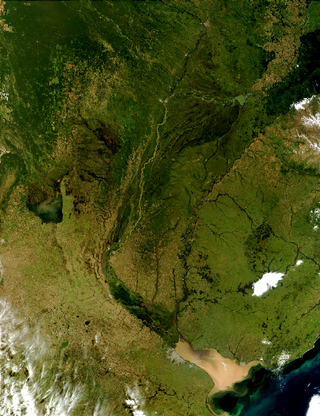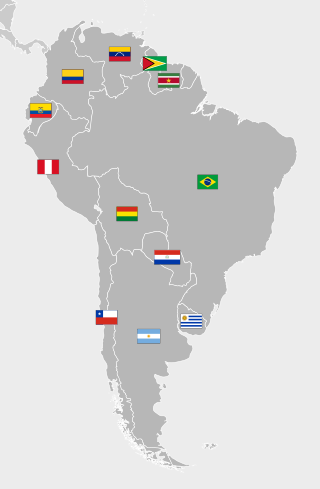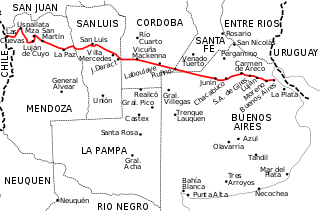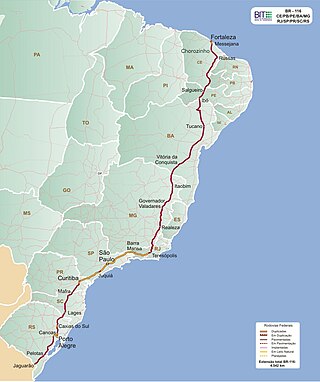Related Research Articles

Transport in Argentina is mainly based on a complex network of routes, crossed by relatively inexpensive long-distance buses and by cargo trucks. The country also has a number of national and international airports. The importance of the long-distance train is minor today, though in the past it was widely used and is now regaining momentum after the re-nationalisation of the country's commuter and freight networks. Fluvial transport is mostly used for cargo.

The Viceroyalty of the Río de la Plata meaning "River of the Silver", also called "Viceroyalty of the River Plate" in some scholarly writings, in southern South America, was the last to be organized and also the shortest-lived of the Viceroyalties of the Spanish Empire in the Americas. The name "Provincias del Río de la Plata" was formally adopted in 1810 during the Cortes of Cádiz to designate the Viceroyalty of the Río de la Plata.

Alfons Hug is a curator, critic and exhibition organizer.
Uair was a low-cost airline based in Montevideo, Uruguay. It operated scheduled regional services to Argentina and Brazil.

The Uspallata Pass, Bermejo Pass or Cumbre Pass, is an Andean pass which provides a route between the wine-growing region around the Argentine city of Mendoza, the Chilean city Los Andes and Santiago, the Chilean capital situated in the central Chilean valley.

The Río de la Plata basin, more often called the River Plate basin in scholarly writings, sometimes called the Platine basin or Platine region, is the 3,170,000-square-kilometre (1,220,000 sq mi) hydrographical area in South America that drains to the Río de la Plata. It includes areas of southeastern Bolivia, southern and central Brazil, the entire country of Paraguay, most of Uruguay, and northern Argentina. Making up about one fourth of the continent's surface, it is the second largest drainage basin in South America and one of the largest in the world.

This is a gallery of flags of South American countries and affiliated international organizations.

Christ the Redeemer of the Andes is a monument high in the Principal Cordillera of the Andes at 3,832 metres (12,572 ft) above mean sea level on the border between Argentina and Chile. It was unveiled on 13 March 1904 as a celebration of the peaceful resolution of the border dispute between the two countries.

The Paso Internacional Los Libertadores, also called Cristo Redentor, is a mountain pass in the Andes between Argentina and Chile. It is the main transport route out of the Chilean capital city Santiago into Mendoza Province in Argentina and so carries quite heavy traffic.
The Second Stage of the 2007 Copa Libertadores was a group stage.

National Route 7 is a road in Argentina. It crosses the country from east to west, from the capital to the border with Chile, thus linking the Atlantic coast with the Andes, crossing the provinces of Buenos Aires, Santa Fe, Córdoba, San Luis and Mendoza. It has a total length of 1,224 km (761 mi), of which 367 km (228 mi) (30%) are freeways.
The Copa Mercosur 2001 was the 4th and final staging of the international club cup.
The Second Stage of the 2011 Copa Santander Libertadores de América ran from February 9 to April 20, 2011.

BR-116 is a federal route of highways of Brazil and the longest highway in the country, with 4,542 km (2,822 mi) of extension. The road connect Fortaleza, Ceará, one of the largest Northeast Brazil metropolises, to the southern city of Jaguarão, Rio Grande do Sul, in the border with Uruguay. It is also the longest highway in the country to be completely paved. It is considered one of the most important highways in the country, along with BR-101.

Portugal–Uruguay relations refers to the current and historical relations between Portugal and Uruguay. Both nations are members of the Organization of Ibero-American States and the United Nations.

Mercosur Cities Network, or simply Mercocities, is a network that unites a group of municipalities of the countries that participate in the Common Market of the South (Mercosur), whether they are members or associates. This organization of cities aims to promote their integration on a regional scale and stimulate development and cooperation between them.
The 2019 Copa Libertadores final stages were played from 23 July to 23 November 2019. A total of 16 teams competed in the final stages deciding the champions of the 2019 Copa Libertadores, with the final played in Lima, Peru at the Estadio Monumental.